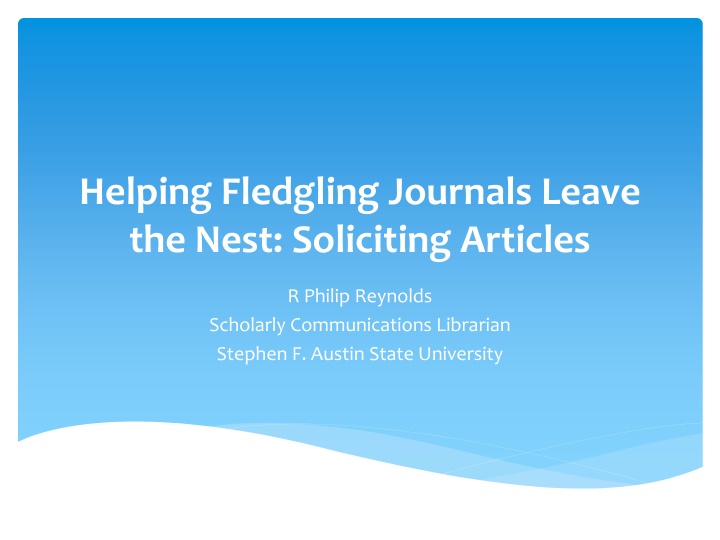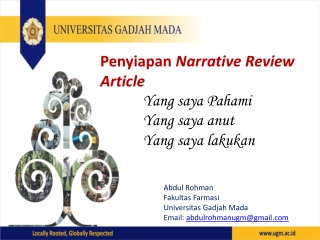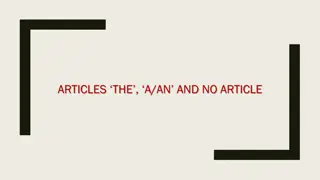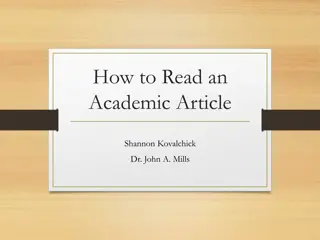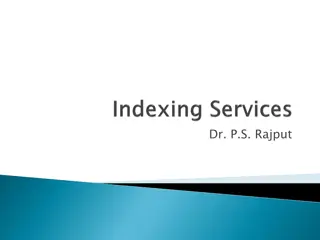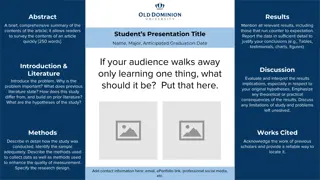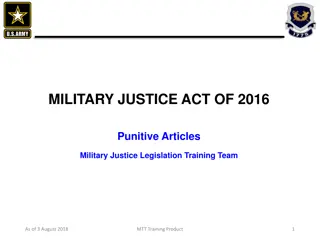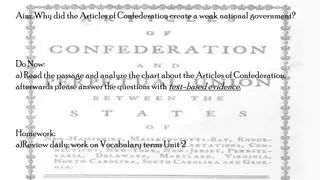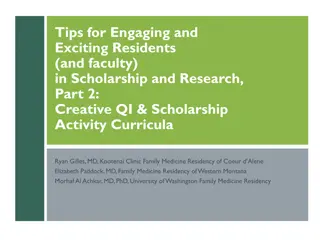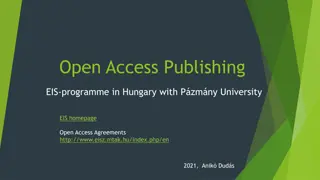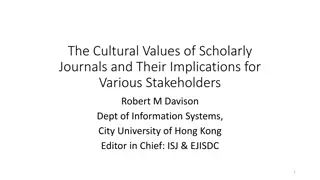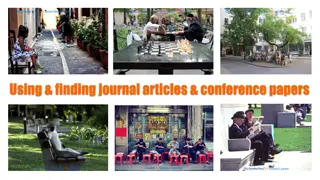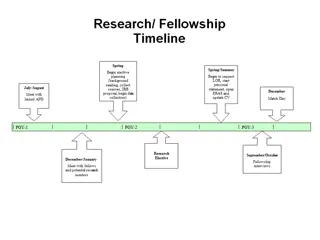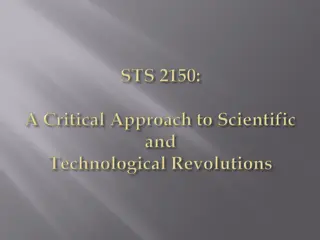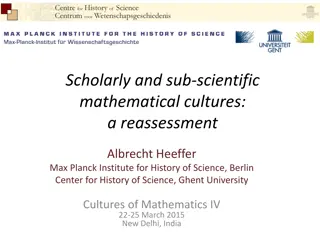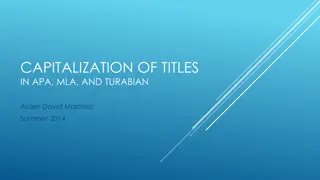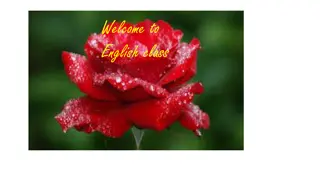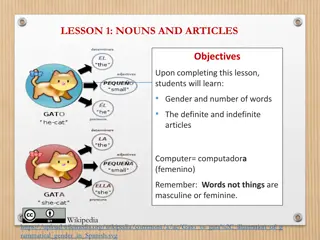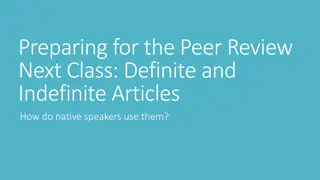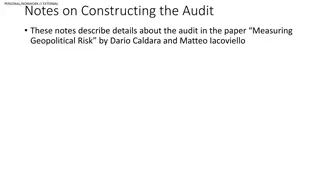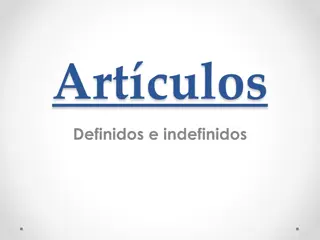Strategies for Soliciting Articles in Scholarly Publishing
Scholarly publishing entails soliciting articles effectively to nurture fledgling journals. This involves utilizing diverse methods such as sending questionnaires, posting flyers, and leveraging traditional publisher services. Editors play a vital role in initiating the process early and engaging multiple avenues for article acquisition. The Manuscript Solicitation Notice exemplifies a proactive approach to invite manuscripts for peer-review, emphasizing the value of geospatial technology in natural resource management. Various strategies are explored to ensure successful article solicitation, fostering a robust publishing ecosystem.
Uploaded on Sep 19, 2024 | 0 Views
Download Presentation

Please find below an Image/Link to download the presentation.
The content on the website is provided AS IS for your information and personal use only. It may not be sold, licensed, or shared on other websites without obtaining consent from the author.If you encounter any issues during the download, it is possible that the publisher has removed the file from their server.
You are allowed to download the files provided on this website for personal or commercial use, subject to the condition that they are used lawfully. All files are the property of their respective owners.
The content on the website is provided AS IS for your information and personal use only. It may not be sold, licensed, or shared on other websites without obtaining consent from the author.
E N D
Presentation Transcript
Helping Fledgling Journals Leave the Nest: Soliciting Articles R Philip Reynolds Scholarly Communications Librarian Stephen F. Austin State University
Services of Traditional Publishers Kent Anderson UPDATED 96 Things Publishers Do (2016 Edition) https://scholarlykitchen.sspnet.org/2016/02/01/guest- post-kent-anderson-updated-96-things-publishers-do- 2016-edition/ If libraries want to be taken seriously as publishers they need to provide services commensurate to those of traditional publishers
The Work of the Editors Begins # 9 Solicitation of materials Soliciting articles should start as early as possible Multiple methods should be exploited and should go beyond list-serves and emails
From the Editors Sent questionnaires to all the editors of our new OA journals Found out how they tried to solicit articles, and how well it worked
Journal of Geospatial Applications in Natural Resources Posted flyers with all accredited forestry programs in the country Posted flyers at national and regional conferences.
Manuscript Solicitation Notice The Arthur Temple College of Forestry and Agriculture, in conjunction with Stephen F. Austin State University, publishes the Journal of Geospatial Applications in Natural Resources with The Center for Digital Scholarship via bepress. The focus of the journal is to publish via a rapid double-blind peer-review process articles that apply geospatial technology to quantify, qualify, map, monitor, and manage natural resources. The purpose of this notice is to solicit manuscripts ready for the peer-review process for the premier issue scheduled in early 2016. We are confident that this exciting new opportunity will allow natural resource professionals an outlet for their applied geospatial research within a natural resource context. Specific information regarding the Journal of Geospatial Applications in Natural Resources Author Guidelines, Author Template Guide, and its Aims and Scope please email: unger@sfasu.edu Daniel R. Unger, Professor of Spatial Science Editor-in-Chief, Journal of Geospatial Applications in Natural Resources Arthur Temple College of Forestry and Agriculture Stephen F. Austin State University P.O. Box 6109 SFA Nacogdoches, TX 75962-6109 Phone: 936-468-2234 FAX: 936-468-2489 E-mail: unger@sfasu.edu
Journal of Human Services: Training, Research, & Practice The journal has a board of 22 editors The executive editor works with board members who can serve as editors or reviewers Dr. Robbie Steward set up a three step process for selecting editors to prepare them to solicit articles
Cast a Broad Net When Recruiting Editors Wanted to recruit both National and International scholars as editors Wanted all disciplines in Human Services represented
Cultivated Editors With Certain Characteristics Editors who demonstrate a commitment to take on the expected workload Editors who demonstrate through training their willingness to work in a positive way with scholars even if their submission was rejected Editors that understood and desired to achieve a high level of competitiveness and impact envisioned by Dr. Steward
Solicit Articles Through Newly Created Social Network Solicit articles from editorial board Additionally editors where to solicit articles from their own campus Finally editors contacted colleagues and prior students from other campuses
MLET Is published for the Professors of Middle Level Education in Texas a regional affiliate association Distributed flyers at several discipline related conferences Talked with and solicited articles from presenters at the association s regional and national conferences
What Else Did They Have to Say It was difficult to recruit enough reviewers If they had gone out and beat the bushes for articles they could have doubled their submissions They needed to work harder to get all of the editors involved in soliciting articles They appreciated the library's support and leadership and wanted to know how they could solicit more submissions
Some Best Practices Start early, content is almost always the hold up Take advantage of targeted professional organizations Use or even create social networks Use individual relationships with colleagues you already know Approach speakers at related conferences Still use emails and listservs
Some Additional Tricks to Try Showcase best article on list-serve Search databases for articles that you wish had been in your journal and contact the author Use Google Scholar to find these articles and contact authors that cited the article or that wrote related articles Use Digital Commons http://network.bepress.com/life-sciences/forest- sciences/
Thank You R Philip Reynolds Scholarly Communications Librarian Ralph W. Steen Library Stephen F. Austin State University preynolds@sfasu.edu
